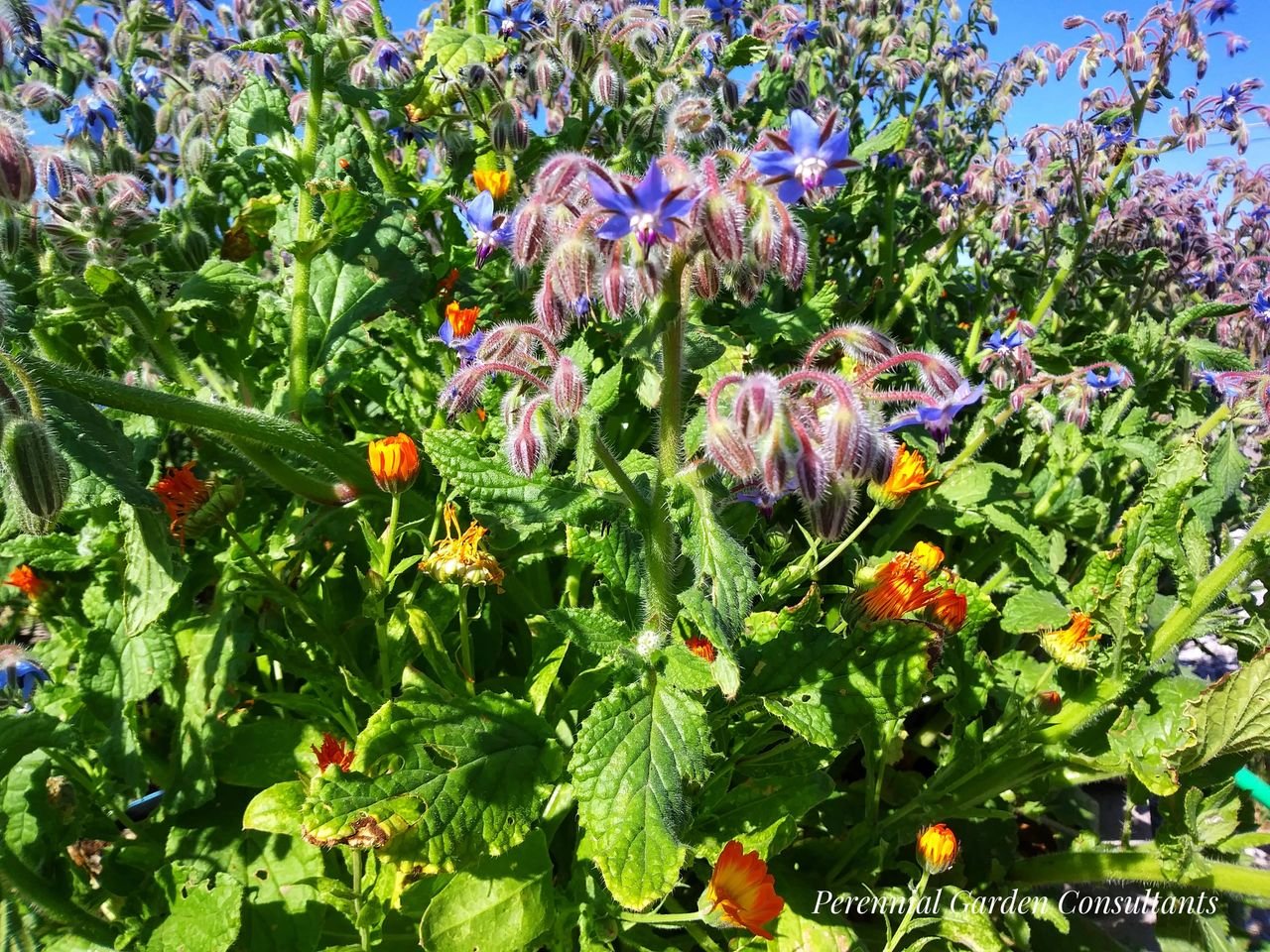Designing the Southwest Pollinator Garden
By Michele Chambliss, Perennial Garden Consultants
I recall one day in early June, standing before a chaste tree, Vitex agnus-castus, in full bloom, watching the air vibrate with gazillions of flying insects humming from flower to flower, simply amazed at their sheer numbers and the energy field they seemed to create around the plant.
However, I discovered that not everyone shares my fascination with buzzing insects. I once suggested the same tree for a client’s backyard, in a corner away from the patio where it could take in the sun while attracting those same insects needed to pollinate her vegetable garden.
In response, I received an email: “No chaste tree! Don’t you know they attract bees?!”
I was not actually out to ruin her outdoor space (we settled upon a different plant she could better appreciate). Yet, contrary to the attitude that bees reduce the quality of life, bees and other pollinators, which include butterflies, flies, beetles, birds, and bats, in fact make life possible!
As a crucial part of our ecosystems, pollinators play an irreplaceable role in plants’ reproductive cycles, which grow the fruits, vegetables, nuts and seeds we—and other animals—depend upon for nourishment and survival.
Due to pesticide use, destruction of habitat, diminishing plant diversity, and disease, pollinators—most notably among them, bee populations—are now in decline. However, by taking small steps, like replacing lawn with native plants, we can help these hard-working insects by providing them with the nectar and pollen they need to live and to feed their young.
In return, we are rewarded with colorful flowers, productive vegetable gardens, and their graceful and endlessly fascinating presence in our outdoor spaces.
A Good Place to Start: The Bean and Pea Family
Known as Fabaceae (or Leguminosae), this plant family of over 750 genera includes the edible beans and peas we enjoy, plus clover and alfalfa, cover crops farmers use to improve the soil and bring in pollinators. Although leguminous plants are recognized for their ability to “fix” nitrogen in the soil because of the symbiotic relationship between plant roots and soil bacteria, it appears the jury is out on whether or not these plants improve desert soils to any measurable degree.
Regardless, a number of garden plants for the Southwest also fall under this category, so it’s a good place to start exploring trees and shrubs for the pollinator garden.
In spring, native trees like mesquite, Prosopis sp., palo verde, Parkinsonia sp., and redbud Cercis sp., are abuzz with bees and other pollinating insects. Trees such as these can help form the “bones,” or structure, of the garden.
TIP! As with any tree-planning, be aware of the mature size of the tree when siting it in the yard to avoid future maintenance headaches.
The ornamental shrubs known as “fairy dusters” become lovely bee magnets when they bloom in spring and summer. Calliandra eriophylla, pink fairy duster, and the Baja fairy duster, Calliandra californica, both make good additions to the pollinator garden. ‘Sierra Starr’ is a hybrid between the two that grows to about 5’ X 5’ and also has flowers that attract bees.
The genus Dalea also consists of several leguminous species favorable to bees. From shrubs, Dalea frutescens, D. pulchra—to groundcover, D. capitata, D. greggii—and perennials, D. purpurea , there’s a Dalea for just about every season and garden situation.
A few notable, non-native shrubs for desert pollinator gardens include cassias that hail from Australia (Senna sp.), and Caesalpinia sp., the ever-popular Mexican bird-of-paradise and yellow bird-of-paradise. All are attractive to bees, pollinators, and people, when in bloom.
HERBS
Drifts of fragrant flowers in white, yellow, and blue beckon to bees to feed! Growing herbs is one of the easiest ways to furnish nectar and pollen to them and other pollinators and beneficial insects.
The white flowers of basil, Ocimum sp., oregano, Origanum sp., thyme, Thymus sp., lemon verbena, Aloysia citriodora, and some mints, Mentha sp., shine as bright beacons to bees. Umbelliferous flowers found in dill, Anethum graveolens, parsley, Petroselinum crispum, and fennel, Foeniculum vulgare, also draw in pollinators and beneficials.
Mediterranean herbs rosemary, Rosmarinus sp., and lavender, Lavandula sp., supply nectar and pollen while blooming during winter and early spring, at a time when flowers are scarce. And of course, the annual herb borage, Borago officinalis, is one of the best bee plants anyone can grow!
ANNUALS AND PERENNIALS
The plants that typically come to mind when planning a pollinator garden—flowers! By growing a variety of annuals and perennials that bloom at differing times throughout the year, we can increase bee diversity and better support pollinator populations.
Desert-cottage garden style lends itself well to a floriferous landscape both pollinators and people are drawn to. But making room for both native and non-native annuals and perennials in any landscape will brighten the space with showy visual cues that draw in pollinators.
Drifts of fragrant flowers in bright white, yellow, and blue beckon to bees to feed! Plant “open-faced” flowers such as sunflower, Helianthus sp.; chocolate flower, Berlandiera lyrata; Coreopsis sp.; and blackfoot daisy, Melampodium leucanthum.
Phacelia sp., Nigella damascena, and Nemophila menziesii are terrific cool-season annuals to start from seed and sport blue blossoms the bees love.
Birds seek out red and orange colors, while butterflies are drawn to purple, in addition to other brightly colored flowers. Annual and perennial verbena, red-flowering penstemons, and lantana fit the bill for these garden visitors.
TIP! There are countless annuals and perennials that can support a thriving pollinator population, so sometimes it can be overwhelming trying to pull it all together cohesively in the home landscape. Consulting with a professional who specializes in these types of gardens can be invaluable.
SUCCULENTS
We are so fortunate in the Southwest to enjoy a wide variety of succulents and cacti, many of which can be found nowhere else in the world.
These plants are part of a unique ecosystem. Many of them have co-evolved with particular insects which help ensure their survival. For example, biologists have discovered that every yucca species has its own moth to pollinate it!
And did you know there are 23 species of cactus bee?
So designing with the ultimate in xeric plants, succulents and cactus, makes perfect sense for us in the Southwest if we want to help our pollinator friends. Prickly pear, Opuntia sp.; Cholla; Yucca; Ocotillo; and saguaro, Carnegiea gigantea, are just a few plants that offer both a striking presence in the desert garden, and food for pollinators when in flower. And cactus flowers are among the most spectacular of any desert plant!
Used as a focal point, accent, or part of a diverse gardenscape that functions as a whole, succulents should be considered valuable additions to the well-designed xeric landscape and southwest pollinator garden.
OTHER WAYS TO SUPPORT LIFE IN THE GARDEN
One of the best ways to encourage pollinators and beneficial insects to visit the garden is to eschew the use of toxic chemicals in the garden. In other words, lay off the pesticides!
Buy plants free of neonicotinoids.
Provide habitat by allowing a bit of “wildness” in one area of the garden, or put up an insect hotel. Leaving some space open and undisturbed can provide habitat for native burrowing bees.
And all wildlife appreciates a water source in the desert—it doesn't have to be elaborate, a small, shallow dish of fresh water will do.
Finding and putting together the right combination of plants to make your garden come alive with pollinators is one aspect of design I specialize in. Consulting with the right professional can put the fun back into your garden project!
Michele Chambliss is a "plant-driven" garden designer based in Las Vegas, NV. An ASHS Certified Horticulturist, she has worked in many facets of horticulture for the past 20 years. Although primarily a garden blogger for Designer's Notebook, Michele has written additional articles readers may find helpful, published online by gardenguides.com.
FOR MORE, CHECK OUT THESE RESOURCES
There is an amazing amount of online information on the topics of bees, pollinators, and pollinator gardens. Although not all of it is geared specifically to the Southwest, much is still relevant to our area.
Great guide with some plant lists for the Southwest Desert https://www.pollinator.org/PDFs/Guides/AmericanSemiDesert.rx8.pdf
Pollinators in the Southwest https://www.fws.gov/southwest/es/Pollinators.html
Native desert bees https://wateruseitwisely.com/desert-plants-and-desert-native-bees-2/
Reducing pesticide use, Xerces https://www.xerces.org/pesticides
https://www.desertmuseum.org/books/nhsd_bees.php
Pollinator research https://www.usgs.gov/centers/pwrc/science/pollinators?qt-science_center_objects=0#qt-science_center_objects
https://davidsuzuki.org/queen-of-green/create-pollinator-friendly-garden-birds-bees-butterflies/










